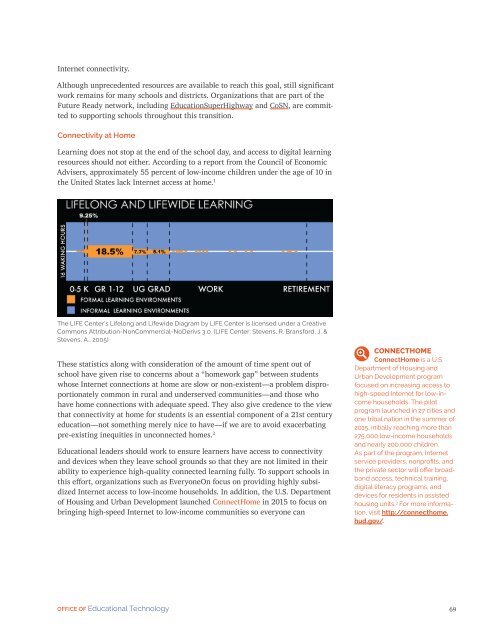Future Ready Learning
7m3sdJ
7m3sdJ
Create successful ePaper yourself
Turn your PDF publications into a flip-book with our unique Google optimized e-Paper software.
Internet connectivity.<br />
Although unprecedented resources are available to reach this goal, still significant<br />
work remains for many schools and districts. Organizations that are part of the<br />
<strong>Future</strong> <strong>Ready</strong> network, including EducationSuperHighway and CoSN, are committed<br />
to supporting schools throughout this transition.<br />
Connectivity at Home<br />
<strong>Learning</strong> does not stop at the end of the school day, and access to digital learning<br />
resources should not either. According to a report from the Council of Economic<br />
Advisers, approximately 55 percent of low-income children under the age of 10 in<br />
the United States lack Internet access at home. 1<br />
The LIFE Center’s Lifelong and Lifewide Diagram by LIFE Center is licensed under a Creative<br />
Commons Attribution-NonCommercial-NoDerivs 3.0. (LIFE Center: Stevens, R. Bransford, J. &<br />
Stevens, A., 2005)<br />
These statistics along with consideration of the amount of time spent out of<br />
school have given rise to concerns about a “homework gap” between students<br />
whose Internet connections at home are slow or non-existent—a problem disproportionately<br />
common in rural and underserved communities—and those who<br />
have home connections with adequate speed. They also give credence to the view<br />
that connectivity at home for students is an essential component of a 21st century<br />
education—not something merely nice to have—if we are to avoid exacerbating<br />
pre-existing inequities in unconnected homes. 2<br />
Educational leaders should work to ensure learners have access to connectivity<br />
and devices when they leave school grounds so that they are not limited in their<br />
ability to experience high-quality connected learning fully. To support schools in<br />
this effort, organizations such as EveryoneOn focus on providing highly subsidized<br />
Internet access to low-income households. In addition, the U.S. Department<br />
of Housing and Urban Development launched ConnectHome in 2015 to focus on<br />
bringing high-speed Internet to low-income communities so everyone can<br />
CONNECTHOME<br />
ConnectHome is a U.S.<br />
Department of Housing and<br />
Urban Development program<br />
focused on increasing access to<br />
high-speed Internet for low-income<br />
households. The pilot<br />
program launched in 27 cities and<br />
one tribal nation in the summer of<br />
2015, initially reaching more than<br />
275,000 low-income households<br />
and nearly 200,000 children.<br />
As part of the program, Internet<br />
service providers, nonprofits, and<br />
the private sector will offer broadband<br />
access, technical training,<br />
digital literacy programs, and<br />
devices for residents in assisted<br />
housing units. 3 For more information,<br />
visit http://connecthome.<br />
hud.gov/.<br />
OFFICE OF Educational Technology<br />
69



